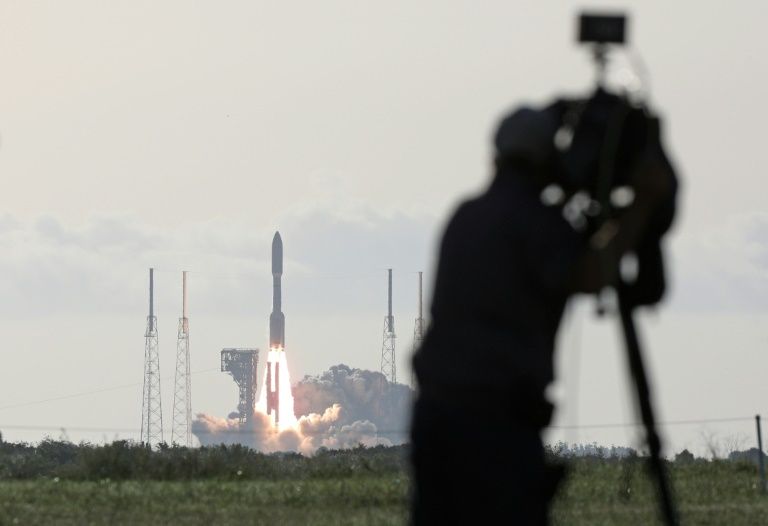NASA’s Perseverance rover bound for Mars to seek ancient life
An Atlas V rocket with the Perseverance rover lifts off from Launch Complex 41 at Cape Canaveral Air Force Station in Florida. ©AFP Gregg Newton
Cape Canaveral (AFP) – NASA’s latest Mars rover Perseverance launched Thursday on an astrobiology mission to look for signs of ancient microbial life on the Red Planet — and to fly a helicopter-drone on another world for the first time.
A United Launch Alliance Atlas V rocket took off on schedule at 7:50 am (1150 GMT) from Cape Canaveral, Florida.
About an hour later, the spaceship carrying Perseverance broke away from the upper-stage Centaur rocket and headed for Mars at 25,000 mph (40,000 kph).
But it was experiencing technical difficulties after passing through the Earth’s shadow which briefly caused its temperature to drop and triggered a “safe mode” that switched off all but essential systems, NASA said.
Matt Wallace, the mission’s deputy project manager, said the issue was not overly concerning, adding: “We’ll know more in a bit.”
If all goes to plan, Perseverance will reach Mars on February 18, 2021, becoming the fifth rover to complete the voyage since 1997.
So far, all have been American. China launched its first Mars rover last week, which should arrive by May 2021.
By next year, Mars could have three active rovers, including NASA’s Curiosity, which landed in 2012.
– Faster and smarter –
Perseverance is an improved version of Curiosity — faster, smarter, and capable of autonomously navigating 200 meters per day.
About the size of a small SUV, it weighs a metric ton, has 19 cameras and two microphones — which scientists hope will be the first to record sound on Mars.
It has a two-meter-long robotic arm, and is powered by a small nuclear battery.
Once on the surface, NASA will deploy the Ingenuity Mars Helicopter — a small 1.8 kilogram (four pound) aircraft that will attempt to fly in an atmosphere that is only one percent the density of Earth’s.
The idea is to lay down a proof of concept that could one day revolutionize planetary exploration, since rovers can only cover a few dozen kilometers in their whole lifespans and are vulnerable to sand dunes and other obstacles.
– A little MOXIE –
Another goal is to help pave the way for future human missions — and a major obstacle is the planet’s 96 percent carbon dioxide atmosphere.
Liquid oxygen can be brought from Earth, or oxygen can be mined from ice underneath the Martian surface.
A simpler approach is converting it from the atmosphere, which is what the Mars Oxygen In-Situ Resource Utilization Experiment, or MOXIE can do, using a process called electrolysis.
The plan is to perform at least 10 oxygen-producing runs using the car battery-sized device under as many different seasonal and environmental conditions as possible.
But Perseverance’s primary mission is to scour the planet for evidence of ancient life forms.
Perseverance’s drill will collect around 30 intact rock cores and place them in test tubes, to be collected by a future joint US-European mission.
Indisputable proof of past life on Mars will most likely not be confirmed, if it exists, until these samples are analyzed next decade, according to NASA chief scientist Thomas Zurbuchen.
– Ancient delta –
NASA has chosen the Jezero crater as its landing site, a giant impact basin just north of the Martian equator.
Between three and four billion years ago, a river flowed there into a large body of water.
“At Jezero we have river valleys that flow into and out of the crater and we know that the lake filled up with water and that overflowed,” geologist Katie Stack Morgan of NASA’s Jet Propulsion Laboratory in California said Thursday.
“We think that Jezero has all the building blocks to support past life.”
The mission is set to last at least two years, but probably much longer given the endurance previous rovers have shown.
Disclaimer: Validity of the above story is for 7 Days from original date of publishing. Source: AFP.


